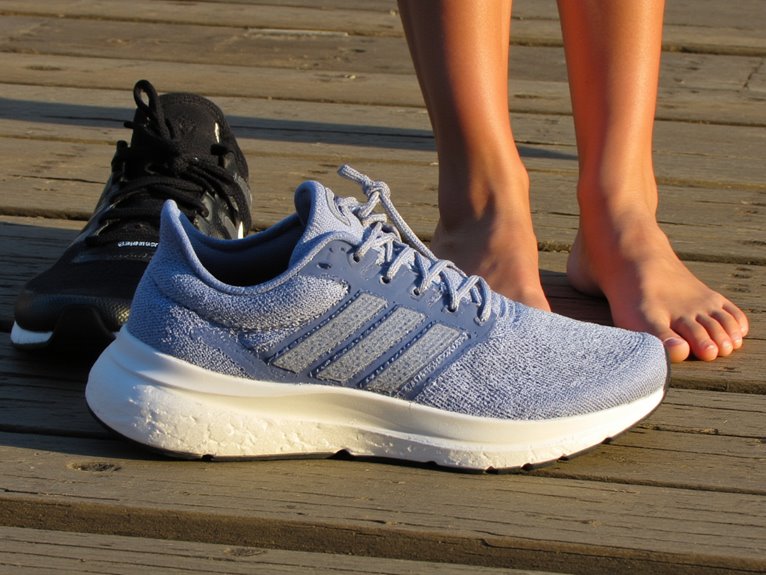Zero-Drop and Minimalist Footwear: Pros, Cons, and Transition Tips
Zero-drop minimalist footwear eliminates heel elevation, positioning your heel and toe at the same height with 3-13mm stack heights for natural movement. You’ll gain stronger foot muscles after six months and improved proprioception, but face 2-3 times higher injury risk during changeover. Common issues include Achilles tendonitis and stress fractures from biomechanical changes. Start with 1-2 hours daily indoor wear for six weeks, then gradually progress over 8 weeks to 6 months. Continue exploring for detailed changeover protocols.
We are supported by our audience. When you purchase through links on our site, we may earn an affiliate commission, at no extra cost for you. Learn more. Last update on 5th January 2026 / Images from Amazon Product Advertising API.
Notable Insights
- Zero-drop shoes eliminate heel elevation and feature minimal cushioning, promoting natural foot positioning and enhanced ground sensory feedback.
- Benefits include stronger foot muscles, improved balance, better toe splay, and optimized movement patterns with midfoot striking.
- Risks involve 2-3 times higher injury rates, including stress fractures, Achilles tendonitis, and metatarsal overload from biomechanical changes.
- Gradual transition over 8 weeks to 6 months prevents injury, starting with indoor wear before progressing to walking and running.
- Monitor soreness levels during adaptation and allow weeks to months for foot structure changes and muscle strengthening adjustments.
Understanding Zero-Drop and Minimalist Footwear Design
While traditional athletic shoes elevate your heel 8-12 millimeters above your toes, zero-drop footwear places both at identical heights to mimic barefoot positioning on level ground. This design eliminates heel elevation completely, creating a flat platform from heel to toe.
Minimalist shoes combine zero-drop with additional features: stack heights of 3-13 millimeters between foot and ground, high flexibility for natural movement, and lightweight construction.
Minimalist footwear integrates zero-drop design with ultra-thin soles, enhanced flexibility, and featherweight materials for authentic ground connection.
The toe box is wider and anatomically shaped, allowing your toes to spread naturally instead of being compressed into narrow spaces. This natural toe splay helps prevent foot disorders commonly associated with restrictive traditional footwear.
Shoe materials emphasize flexibility and ground feedback. Soles remain thin and flexible to maximize natural foot movement. However, lab measurements reveal discrepancies in drop classifications among brands, highlighting the importance of understanding actual heel-to-toe specifications.
These design elements work together, reducing interference with your natural biomechanics while encouraging forefoot or midfoot striking patterns rather than heel strikes.
Health Benefits for Posture and Musculoskeletal Function
Beyond their unique design characteristics, minimalist shoes deliver measurable improvements to your body’s structural foundation and movement patterns. Research demonstrates that consistent minimalist footwear use increases foot muscle strength by an average of 57.4% after six months. This enhanced muscle engagement activates intrinsic foot muscles that regulate your arch and promote natural biomechanics.
Your foot structure adapts markedly during the adjustment period. Studies show increased foot width and improved range of motion throughout your posterior chain muscles.
These changes strengthen your body’s foundation through:
- Enhanced sensory feedback via cutaneous mechanoreceptors
- Reduced postural sway from neutral heel-to-toe positioning
- Active foot and ankle muscle control replacing passive support
The absence of engineered support structures demands intrinsic musculoskeletal activation, optimizing load distribution across foot joints while reducing impact forces during walking.
Enhanced Balance and Natural Movement Patterns
As your body adapts to minimalist footwear, you’ll experience dramatic improvements in balance control and movement efficiency that extend far beyond basic muscle strengthening.
Zero-drop shoes promote midfoot strike patterns that increase ground contact area, delivering superior grip and lateral force control. The wider toe boxes engage your toes dexterously during stance phases, while reduced midsole cushioning enhances proprioception for finer gait adjustments.
This enhanced sensory feedback enables real-time movement corrections on varied terrains. You’ll develop shorter ground contact times, correlating with higher cadence and improved gait efficiency.
The flat sole design maintains neutral foot positioning, aligning your hips, knees, and ankles for ideal balance improvement. Greater ankle flexion reduces impact forces on joints while supporting natural limb kinematics throughout your stride cycle.
Potential Risks and Common Challenges
The enhanced sensory feedback and improved movement patterns that minimalist footwear provides come with significant risks that you must carefully consider before making the change.
While minimalist footwear offers enhanced sensory feedback and improved movement patterns, these benefits come with significant injury risks requiring careful consideration.
Studies reveal runners experience 2-3 times more injuries during training compared to traditional shoes. Footwear biomechanics change dramatically without heel elevation and cushioning, placing excessive strain on your Achilles tendon and calf muscles.
Common injury patterns include:
- Stress fractures and metatarsal overload from altered loading patterns
- Achilles tendonitis and calf strains from increased plantar-flexor demands
- Cuts and bruises from reduced sole protection against environmental hazards
Your adaptation period requires weeks to months of gradual adjustment.
Effective injury prevention strategies must account for individual foot morphology and existing biomechanical patterns before switching footwear types. While minimalist shoes emphasize thin soles and minimal cushioning, traditional hiking shoes prioritize cushioned insoles and arch support to reduce impact stress during extended outdoor activities.
Safe Transition Strategies and Timeline
Successfully moving to minimalist footwear requires a methodical approach that spans 8 weeks to 6 months, depending on your current conditioning and footwear history. Shifting phases must follow a structured progression to prevent injury and guarantee proper adaptation.
| Phase | Duration | Activities |
|---|---|---|
| Initial | Weeks 1-6 | 1-2 hours daily indoor wear |
| Intermediate | Weeks 6-16 | Add gym sessions and walking |
| Advanced | Weeks 16-24 | Half-day work integration |
Progress tracking becomes essential during each phase. Start with brief intervals when running-alternate one minute in zero-drop shoes with conventional footwear. Monitor soreness levels daily and adjust accordingly. Use intermediate 4-6mm drop shoes as stepping stones. Your calves and Achilles tendons need gradual strengthening time. Expect initial discomfort as normal adaptation. Full exclusive use often requires 6+ months depending on previous footwear differences.
Choosing the Right Zero-Drop Shoes for Your Needs
Selecting zero-drop shoes isn’t about finding one perfect model-it’s about matching specific design features to your foot shape, activity level, and shift timeline.
A thorough fit assessment starts with measuring your foot width and volume. Wide toe boxes prevent deformities and allow natural toe splay, while stack height determines ground feel versus protection.
Brand comparison reveals distinct specializations:
- Merrell Vapor Glove 6: Ultra-minimal at 5.6 oz with 7.6mm stack height for authentic barefoot experience
- Topo Athletic Pursuit 2: Moderate cushioning ideal for zero-drop beginners requiring comfort
- Vivobarefoot Primus Lite: Versatile breathability and durability for running and casual wear
Consider your primary use case. Trail runners need aggressive Vibram outsoles, while road runners benefit from flexible midsoles.
Stack height varies from 7.6mm to 20mm-choose based on your protection needs. Many users recommend ordering a half-size up to accommodate proper sizing and ensure comfort during extended wear.
For those planning long-distance adventures, prioritize shoes weighing under 2 pounds per pair to minimize fatigue and maximize performance over extended miles.
Frequently Asked Questions
Can I Wear Zero-Drop Shoes if I Have Flat Feet or High Arches?
You can wear zero-drop shoes with flat feet considerations including gradual change and muscle strengthening. High arches benefits from combining zero-drop shoes with custom orthotics for proper pressure distribution and support.
How Much Do Quality Zero-Drop Shoes Typically Cost Compared to Regular Shoes?
Quality zero-drop shoes cost $80-$150, similar to regular running shoes. You’ll find budget options around $40, but shoe durability may suffer. This price comparison shows zero-drop shoes aren’t necessarily more expensive than traditional footwear.
On a final note
You’ll need patience and consistency when shifting to zero-drop footwear. Start with 15-20 minute sessions and gradually increase duration over 8-12 weeks. Your feet, calves, and Achilles tendons require time to adapt to the altered biomechanics. Listen to your body’s signals and don’t rush the process. With proper shifting techniques and appropriate shoe selection, you’ll likely experience improved posture, enhanced proprioception, and more natural movement patterns.

